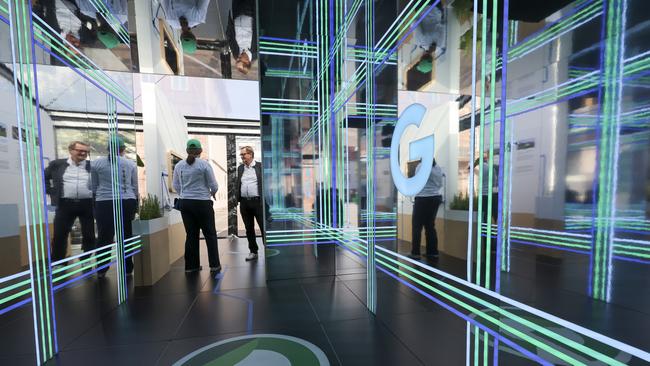
Barely anyone will notice when it does happen, but this “switch” could offer the best hope yet for Australia’s productivity malaise and represents a rewiring of the economy.
It’s part of an ambitious ultra-high speed digital network linking Australia’s capital cities that Telstra has quietly been building for the past three years. The first leg connects Sydney to Canberra and is set to go live on June 25.

In decades past, a cable connecting cities would have attracted prime ministers, premiers and TV cameras. However, in an age of wi-fi and cloud computing, a physical network seems like an oddity. Switching it on will happen largely unnoticed. There won’t be a politician in sight.
Where the Canberra-owned NBN connects properties and businesses within a city, it and other businesses and households rely on cables like the one Telstra is laying and its existing backbone network that connect cities to one another. But this new network is the equivalent of building 100 Sydney Harbour Bridges (or West Gate Bridges) all with the job of carrying a stupefying amount of data and future artificial intelligence traffic at the speed of light.
The cable is about as thick as three pens lashed together and has been laid from Telstra’s Haymarket exchange in Sydney and heads south-west through Wollongong before turning sharply inland at Manar, then hooking into the telco’s Deakin exchange in Canberra’s northern suburbs.
The $1.6bn project is remarkable in many ways. The first is that it represents infrastructure, wholly financed and delivered by the private sector, designed to meet a very public need in the economy.
The second and even more remarkable thing is that the project, a massive exercise in construction and planning, has so far been delivered at all.
It was first flagged three years ago as the inflation bubble was just taking off. ChatGPT’s AI model hadn’t even been released. And so far, the project is on time and on budget.
The cable doesn’t stop at Canberra. It heads south over the Snowy Mountains at Cooma, past the trouble-plagued Snowy Hydro project. Then it’s all the way down the Monaro Hwy through to Victoria, across Gippsland and then on to Melbourne’s outer suburbs. This southern leg will go live some time in the September quarter.
Beyond that there’s more cables connecting Adelaide, Brisbane and then Perth being laid. There’s another two more cables being laid between the triangle of Sydney, Canberra and Melbourne, but adding to cost they will track a different route inland to provide security in case there’s a problem at Wollongong.
“This is not for the faint-hearted,” says Brendon Riley, who heads up Telstra’s infrastructure business and is overseeing the build.
To give a sense of the complexity across the Sydney, Canberra, and Melbourne routes, Telstra has issued 3000 land access activity notices, completed more than 1700 land surveys, and issued 1100 construction certificates and notices. There’s more than 170 cultural heritage and environmental service surveys. Works have been halted for lambing season, snow and wildlife location. “And mud. A lot of mud,” Riley says.
Digital horsepower
As well as building out capacity for households watching more Netflix and online gaming, Telstra is betting on an explosion in demand for hyperscalers. These are the giant data centres that provide the horsepower for AI computing.
The cables are made up of 144 optic fibre “pairs” and set a benchmark for carrying data across long distances at high speeds. They carry the equivalent of 83 terabits per second per fibre pair. That’s the equivalent of downloading Netflix’s entire library in an instant. Along the 1100km route between Sydney and Melbourne, there are dozens of booster sites or mini edge stations.
These are the equivalent of pumping stations that push through data capacities at speed. Satellites or wireless network can’t compete at either speed and low latency or delay.
Telstra’s plan is to provide the pipeline hooking up the big data users – and charge a premium for it. There’s around 80 data centres dotted across Sydney and Melbourne built by the likes of AirTrunk, Macquarie, Next DC or Goodman and dozens more to come. Nationwide, there’s around 150. The foundation customer underwriting a large chunk of the project is Microsoft, the global tech giant which is rolling out its AI tools to business customers.
The Telstra network will also offer “dark fibre” capacity, which is essentially a dedicated section of fibre pairs for exclusive use, expected to be taken out by big data users like banks, government or hyperscalers.

The explosion of the digital economy, and the new momentum given by AI, is giving new purpose to the big incumbent telcos, which are sitting on valuable digital infrastructure. And investors are starting to take note.
Last year Vocus, owned by Macquarie’s Group’s asset management arm, paid a stunning $5.2bn for TPG’s high-capacity fibre network. Macquarie led a $3.5bn buyout of Vocus four years ago. A second operator HyperOne, backed by tech entrepreneur Bevan Slattery, plans to build its own rival national network.
Telstra chief executive Vicki Brady this week set a new vision for her telco, which was one where the network was the product.
For Australia, there’s a bigger stake at play than Telstra’s revenue line. The more capacity built out to support high speed data exchange will inevitably make the nation smarter.
“For Australia to be competitive, for businesses and industries to be competitive, to keep competing on a world stage and drive forward productivity and prosperity in the country, it’s how quickly you adopt the technology. You don’t need to own the invention of it. That’s the thing that’s really important,” Brady says.
“Everyone talks about these large language models, they’re all in the US, and they’re not here in Australia. Actually, I think where the opportunity is how quickly you adopt, and you really apply that technology across organisations around the country.”

After toying with AI for the past few years, Australian companies are now starting to seriously sweat AI technology with an aim to drive productivity. Some of this will have a real world impact on jobs, but no one really knows what it will look like. Brady acknowledges Telstra’s own workforce is likely to be smaller by the end of the decade, given the contribution of AI in the running of the business.
Other companies like retailing major Wesfarmers have outlined a user case for AI in making its supply chain more efficient. Wesfarmers’ brands like Bunnings and Kmart also use the technology at the front end, underpinning digital sites and loyalty schemes. Other retailers like Myer have stepped up use of AI. The major banks are among the biggest users of AI use in Australia, using the technology to write code for its banking platforms or answer customer questions. Westpac recently created a new chief data, digital and AI role, reporting directly to CEO Anthony Miller.
Commonwealth Bank’s chief executive Matt Comyn has described AI technology as having the potential to become a “transformational” force for business and the economy.
However, to make this happen, it’s still going to need old-world physical infrastructure like Telstra’s digital highway. The opening in a few weeks won’t be as glamorous as opening a real highway or high-speed train, but the economic impact will be far more profound.






In coming weeks, the equivalent of a virtual switch will be flicked on in a low-rise tower on the edge of Sydney’s CBD.